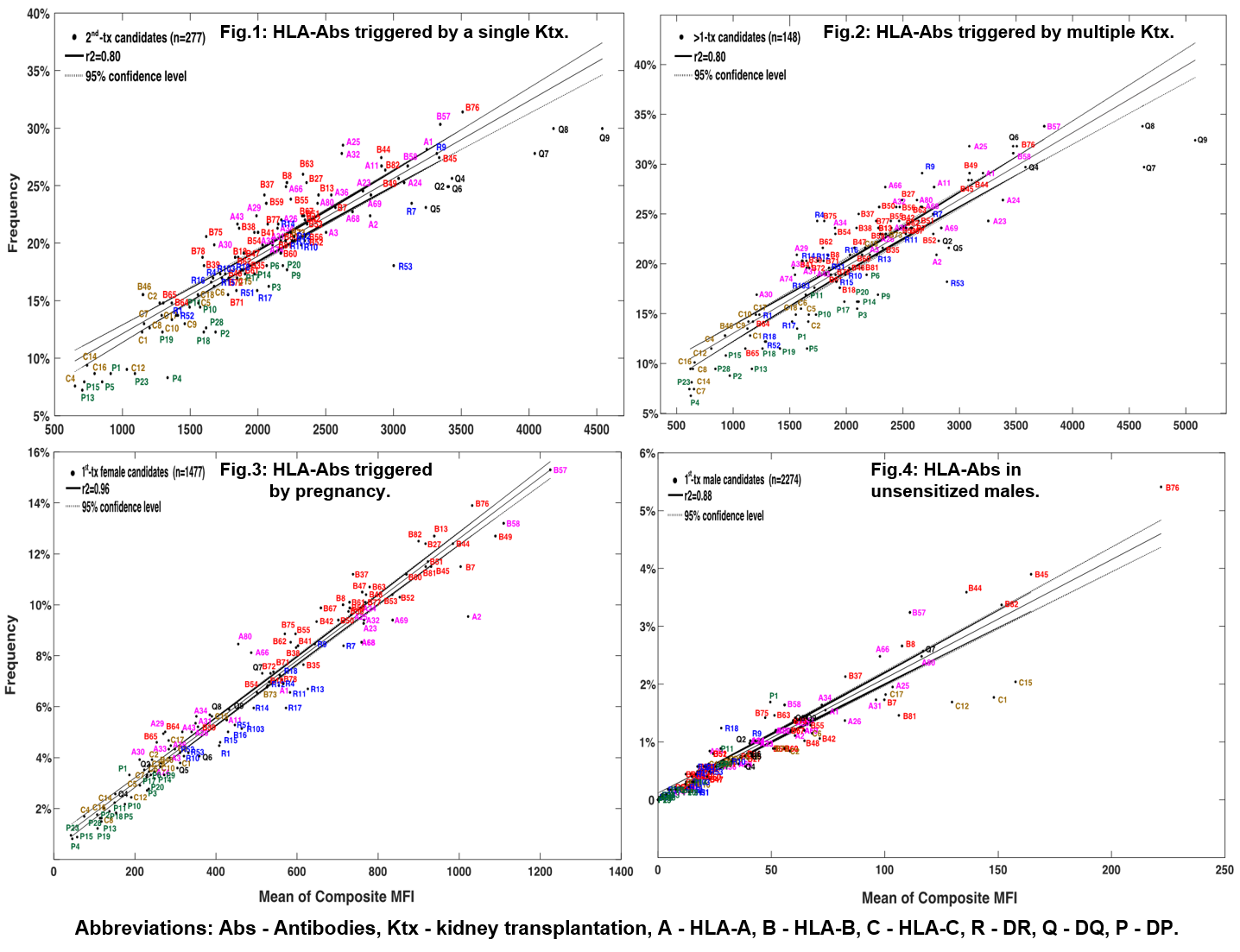Antibody Analysis of 4176 Candidates waiting for Kidney Transplantation Discover the Hierarchy of Antibody-Provoking HLA Types that Warrant Matching in Kidney Transplantation
Raja Rajalingam1, David D Gae1, Kelly Cunniffe1, Owen Buenaventura1, Gilberto da Gente1, John P Roberts2.
1Immunogenetics and Transplantation Laboratory, Department of Surgery, University of California, San Francisco, CA, United States; 2Transplant Services, Department of Surgery, University of California, San Francisco, CA, United States
Introduction: It is crucial to identify the allogeneic exposure that triggers antibody (Ab) production against a broad spectrum of HLA allotypes and to develop strategies that will minimize such broad sensitization to improve kidney allocation and allograft survival. Here we examined the ability of 121 core HLA types in provoking Ab production upon distinct exposures, such as kidney transplantation (Ktx), pregnancy, and pregnancy+Ktx.
Method: A cohort of 277 candidates (44% female) waiting for 2nd-Ktx was analyzed for HLA-Ab. All were Ab-negative prior to 1st-Ktx, and thereby HLA-Abs detected in re-list sera were apparently due to 1st-Ktx. The frequency and strength (mean of composite MFIs) of these 1st-Ktx-induced Abs were compared with those obtained from candidates waiting for 3rd and more Ktx (n=148), and candidates waiting for the 1st-Ktx (1477 females; 2274 males). All sera were pre-treated with DTT to remove interfering factors, and One Lambda single antigen assay was used to measure HLA-Abs. LABXpress automation was used to minimize inter-assay MFI variation.
Results and Discussions: The most prominent Abs (most frequent and strongest) produced by 1st-Ktx are DQ-specific, followed by Abs are directed to DR53-Cross REactive Group (CREG) of antigens and A2-CREG (Fig.1). The hierarchy of 1st-Ktx-induced Abs based on prominenceis DQ9>DQ8>DQ7>B76>DQ4>DQ6>DQ2>B45>B57>DR9>A1>DQ5>DR7>B58>A24>DR53>B49> B82>A11>B44>A69>A2>A23>A68>A25>A32>B7CREG>A10CREG>B5CREG>DR52CREG>DR51CREG>Cw/DP. No gender difference observed in 1st-Ktx-induced Abs constellation (frequency and strength), which indicate that prior pregnancies do not aggravate HLA-Ab production following Ktx. The constellation of HLA-Abs in candidates waiting for 3rd and more Ktx (n=148) is comparable to those of 2nd-Ktx waitlist candidates (Fig.2), indicating multiple Ktx do not exacerbate the immunogenic potentials of HLA types.
Pregnancy-induced HLA-Ab constellation (in females waiting for 1st-Ktx) is very different from those induced by Ktx (Fig.3). The most abundant pregnancy-induced Abs are specific to HLA-B and A2-CREG antigens. Over 60% of males waiting for 1st-Ktx are Ab-negative. The following Abs are detected at a frequency of 2-5% in the unsensitized males, and hierarchy based on prominence is B76>B45>Cw15>B82>Cw1>B44>Cw12>DQ7>A80>B57>B8>B81>A25>Cw17>B7>A66>A31>B37>A26 (Fig.4). Most of these Abs were <4000 MFI, do not belong to specific locus/CREG, do not cause positive crossmatch, negative with another vendor reagents, and have non-specific reactivity.
Conclusions: HLA-DQ, DR53-CREG, and A2-CREG antigens are most aggressive Ab inducers following Ktx (strongly immunogenic) and must be considered for matching in Ktx. Priority for HLA-B and A2-CREG matching will benefit female candidates as they commonly produce Abs to these antigens during pregnancy. HLA-Abs detected in unsensitized males require additional scrutiny to confirm their validity.
